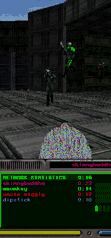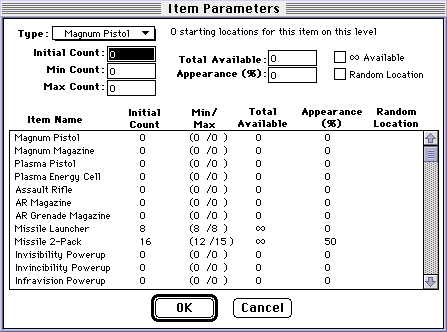
|
|||
|
 |
DO'S 1. Read the Don'ts list. |
|
|
||
| When setting up the item parameters, be mindful of which weapons you want to have available. Also keep in mind that Marathon checks every fifteen seconds to see if it should put down another item. That is, it goes through all the item parameters every fifteen seconds and puts down items accordingly. Read below for explanations of what all the parameters do. | ||
|
Initial count is simply the number of this item that start off on the level when the game begins. For solo levels, you can usually just use this parameter for items. The initial count overrides the maximum count. Minimum count is the minimum number of this item on the map. The minimum count overrides the maximum count, if the maximum count is lower than the minimum. It also overrides the "total available". Keep in mind that the minimum and maximum counts include weapons that players are carrying. For example, if there is a minimum of 4 shotguns on a map, and all are being carried by players, Marathon won't put down another one until someone dies. |
 |
|
|
Maximum count is as it says. Use this parameter as an upper limit on the number of items. It's only really useful if you're using the %-chance regrow feature. (Read: you don't need to use this at all if you don't want to. You can do all the item parameters with the minimum count. Powerups are a good example of an item that minimum counts don't work well with. If a powerup has a minimum of 1, it will always appear. Powerups are destroyed when picked up.) Total Available this refers to the maximum number of times that Marathon will drop this item. Remember that the minimum count ignores this. I use the "infinite available" for all my netmaps. The only time I use the Total Available is if I want to restrict the number of powerups that appear on a level. Then again, I can't remember ever wanting to do this. Rule of thumb: Always use the "infinite available" for any objects that regrow with the "Appearance(%)". Appearance(%) this is a percent chance, checked every fifteen seconds to see whether an item should be placed. If the maximum count is already filled, no item will be dropped. This is useful for powerups. A 5% chance relates to the item appearing once or twice in a ten minute game. Anything over 35% means that the item will appear every minute or so. Random Location, the item will not appear at placed starting locations, but instead will appear randomly in polygons. To keep items from appearing in certain places, you can set the polygons as "Item impassable" or "monster impassable". |
||